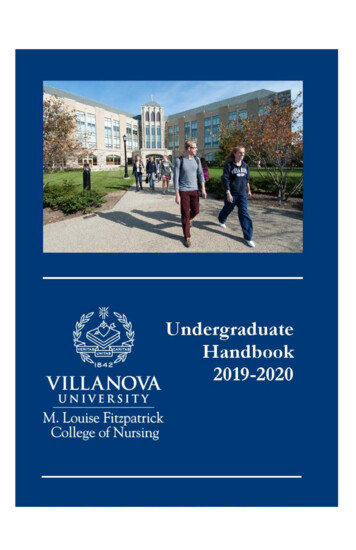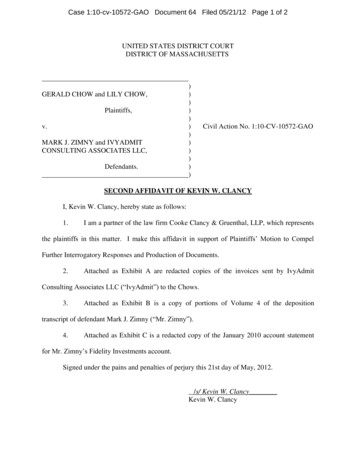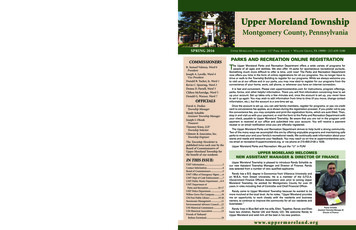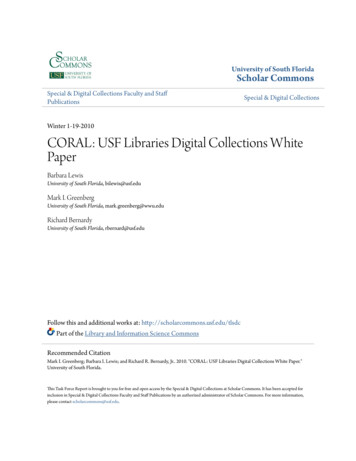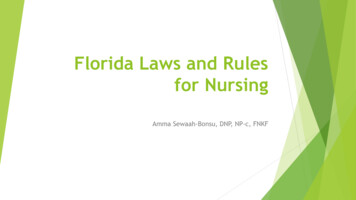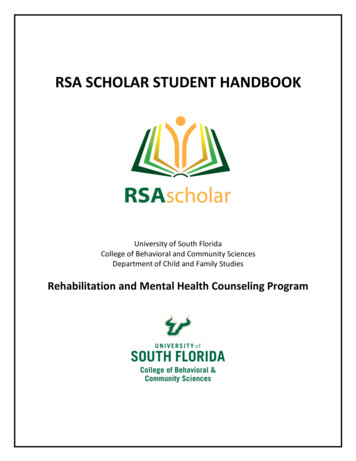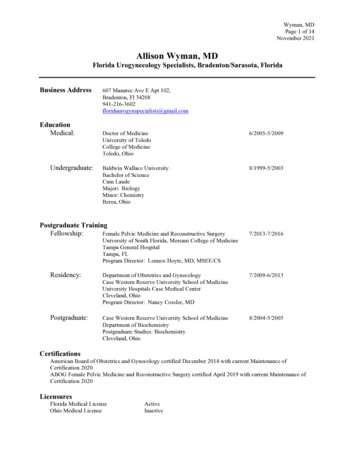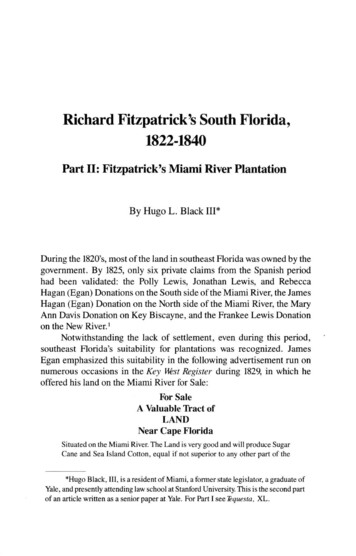
Transcription
Richard Fitzpatrick's South Florida,1822-1840Part II: Fitzpatrick's Miami River PlantationBy Hugo L. Black III*During the 1820's, most of the land in southeast Florida was owned by thegovernment. By 1825, only six private claims from the Spanish periodhad been validated: the Polly Lewis, Jonathan Lewis, and RebeccaHagan (Egan) Donations on the South side of the Miami River, the JamesHagan (Egan) Donation on the North side of the Miami River, the MaryAnn Davis Donation on Key Biscayne, and the Frankee Lewis Donationon the New River.1Notwithstanding the lack of settlement, even during this period,southeast Florida's suitability for plantations was recognized. JamesEgan emphasized this suitability in the following advertisement run onnumerous occasions in the Key West Register during 1829, in which heoffered his land on the Miami River for Sale:For SaleA Valuable Tract ofLANDNear Cape FloridaSituated on the Miami River. The Land is very good and will produce SugarCane and Sea Island Cotton, equal if not superior to any other part of the*Hugo Black, III, is a resident of Miami, a former state legislator, a graduate ofYale, and presently attending law school at Stanford University. This is the second partof an article written as a senior paper at Yale. For Part I see Tequesta, XL.
34TEQUESTATerritory. There is at present a number of bearing Banana and Lime treesand the fruit is inferior to none raised in the Island of Cuba. The forestgrowth consists principally of Live Oak, Red Bay and Dog Wood.Any person desirous of purchasing a valuable plantation will do wellto visit the Land.2On December 1, 1830, Fitzpatrick took James Egan up on his offer,paying 400.00 for "640 acres more or less" on "the Sweet water orMiami River." 3 Fitzpatrick continued to buy land in the area, and byApril 21, 1835, he had acquired the title to every inch of privately heldland in southeast Florida except for the previously mentioned Mary AnnDavis Donation on Key Biscayne. 4 Fitzpatrick's total purchasesamounted to 2,660 acres on both sides of the Miami River (over foursquare miles), and another 640 acres, one square mile, on the New River.The 2,690.00 he had spent in total averaged out to only 81 cents peracre, far less than what agricultural property was selling for in thecomparable sugar lands of East Florida. Fitzpatrick not only had acquired good land for a plantation with a minimal capital outlay, he hadalso placed himself in a good speculative position. If he could firmlyestablish and then make known that the area was fit for plantations, thenhe would stand to profit enormously from the appreciation in value of theland to a price even remotely approaching the price common in EastFlorida.The people who owned the land in southeast Florida before Fitzpatrick were yeomen farmers like those who made up so much of thepopulation of Florida at the time. Although these farmers were notwealthy and owned few if any slaves, their improvements were by nomeans negligible. An investigation of the Lewis family tract on NewRiver by the Spaniards stated that:. Mr. Lewis had lived in that house for several years. had a plantation two milesto the west of this house. [and] had five horses. The house stands on a pine bluffsouth of the river-a small fowl house opposite-about 30 yards from the dwellinghouse up the river stands a small house which we found to be a blacksmith's shopwith a forge, bellows. [and] a small anvil-a chest with sundry tools in it belongsto Lewis.sDr. Benjamin Strobel visited Cape Florida in 1829 and left anotherdescription of one of these yeomen farmers' properties:. The point of land to which we steered our course was steep and perpendicular,consisting of a wall of limestone rock, twelve or fifteen feet above the level of thewater. At one of these we landed, and ascending a rude flight of steps, I foundmyself at the door of a new palmetto hut which was seated on the brow of the hill.It was quite a romantic situation. The cottage was shaded on its western aspect by
RichardFitzpatrick'sSouth Florida 35several large West Indian fruit trees, whilst on its eastern side we found a grove ofluxuriant limes, which were bowing to the earth under the weight of their goldenfruit. This was the residence of the old lady to whom I had been recommended andwho was bordering on 80 years of age. I entered the house and made my devoirs.She received me graciously and placed before me some Palmetto and Icaca plumsand after refreshing, politely conducted me herself over her grounds and showedme a field of potatoes and corn which she had cultivated. She generally employedseveral Indians for this purpose, who for their labor received a portion of theproducts. 6In the New River area on Frankee Lewis' Land, William Cooley hadestablished the most ambitious project in the southeast Florida area.With the help of two negro slaves, Cooley had since 1825 been farmingand manufacturing arrowroot starch. 7 Fitzpatrick apparently rented theland to Cooley after Fitzpatrick bought the Frankee Lewis tract, forCooley continued his operations until the whole area was deserted in1836. The account of what the Indians had destroyed of Cooley's plantation in 1836 included "20 acres of Land cleared - six acres planted inSugar Cane - two acres of Bermuda Arrow Root - the balance of landplanted in corn, potatoes, pumpkins and etc.," as well as citrus fruits andcoconuts. In 1836 the Cooley farm was valued at 12,700, including ahouse, 20 x 55 feet, "one story high built of cypress logs sealed andfloored. ", a storehouse full of provisions, including flour, pork, beets,coffee, corn, grits, rice, salt, sugar, butter and 21 gallons of wine; a"Machinery House 27 x 14 with all the machinery for making arrow root,with a wharf attached."; and livestock which included eighty head ofhogs, five sheep, three horses, and "a lot of Fowls". 8The plantation Fitzpatrick established on his lands on the MiamiRiver differed from these yeoman farmer's efforts not only in scale, butalso in kind. Fitzpatrick's agricultural effort, like Fitzpatrick himself,was of a totally different class - not a farm, owned by a yeoman farmer,but a plantation, owned by a planter. Fitzpatrick's plantation was thesame type of agricultural effort which all over the south was the cornerstone and pinnacle of a distinct economic system, presided over by adistinct class, the planters. The establishment of Fitzpatrick's plantationheld out the promise of firmly grounding a planter society in SouthFlorida in the economic system most compatible with that society.Fitzpatrick's agricultural improvements concentrated on sugarcane. By January of 1836, Fitzpatrick had 100 acres of sugar cane undercultivation, as well as a wide variety of other crops. He had thirty acres ofcorn and pumpkins, five acres of sweet potatoes, four thousand plantainand banana trees, twelve acres of Bermuda arrow root, "a fine lime
36TEQUESTAgrove, yielding at that time from three to five hundred barrels of limes perannum," one hundred coconut trees, and an additional "nursery oftropical fruit trees." For livestock, Fitzpatrick had one hundred head ofhogs, and ducks, fowl, turkeys, and guinea fowls. The wooded areas ofFitzpatrick's land were also of value, for Fitzpatrick kept on hand largequantities of previously cut wood from his plantation with which tosupply fuel for passing steamers? The following schedule made tosupport his late claim for reimbursement from the U.S. Government forthe occupation of his plantation during the Second Seminole War included: everything Fitzpatrick had on the plantation in 1836, each with itsapproximate value. Not listed were the "fifty or sixty" slaves Fitzpatrickhad working the plantation. '1One Hundred acres of sugar cane, worth 100 per acre .Thirty acres of corn and pumpkins, worth .Five acres of sweet potatoes, worth .Four thousand plantain and banana trees .Twelve acres of Bermuda arrow root .Lime grove destroyed .One hundred coconut trees destroyed .Nursery of tropical fruit trees destroyed .Six hundred bushels of flint corn .One hundred head of hogs .Poultry, viz: ducks, fowls, turkeys and guinea fowls .One large flat boat, sixty feet long (cost) .One clinker-built boat . .O ne cedar boat .One schooner .One framed house .Two corn cribs .S O ne kitchen .O ne poultry house .One hewed log house .Twelve negro houses .One framed house, south side Miami River .One framed house, smaller .Two framed houses and out-buildings purchased from Lewis .Plantation tools, blacksmiths' tools, carts, ploughs, axes, hoes,grubbing hoes, cooking utensils, etc. and etc. .Furniture, bed clothes, books, etc .Three years' occupation of my plantation by the United Statestroops at Fort Dallas, Miami River .Four thousand shingles .Three hundred cords of wood, cut from my land to the first of April,1840 for the use of the United States steamers employed on thecoast of Florida, at 6 per cord .Two hundred cords of wood, cut from my land at New river for theUnited States steamboats, at 6 per cord .House and improvements, including fruit trees, wharf, etc.purchased of William Cooley, on Little River . 0018,0002401,8001,2002,500 60,320"
RichardFitzpatrick'sSouth Florida 37The soil and climate of southeast Florida were remarkably suitedfor the growth of tropical products. Speaking in response to an ArmyColonel who had tried to denigrate the productiveness of Fitzpatrick'sland, Stephen R. Mallory wrote about the munificent bounty of the soilin the southeast Florida area:. His entire statement relative to the unsuitableness of Fitzpatrick's plantation forthe culture of tropical fruits, is an error. The place and the country around it areadmirably adapted to their culture, and many of them, as the orange, lime, lemon,sugar apple, coconut, and guava, had been growing there for forty years, when thetroops took possession. He is in error, also, in relation to all that he says about theculture of the banana and plantain and a market for them. While Fort Dallas wasthus occupied by troops, I with a company of forty men, in seven boats, visited abanana grove near the Miami, and found the fruit in greatest abundance. We tookas much of it as we could dispose of in our boats, without making much impressionupon the quantity in the grove. He is equally in error in relation to the quantity andcharacter of the pine timber at the Miami. It is a superior article for steamboats. 12Mallory, who lived on the plantation for a year in 1831 and later became aU.S. Senator from Florida, described the value of the actual plantationitself thus:I am well acquainted with "Fitzpatrick's plantation", in Florida. It occupies bothbanks of the beautiful little River Miami, at its mouth, and is known as CapeFlorida. The climate is tropical,and all the fruits of the tropics grow, or will growwithout replanting. but for the Indian war it would now have been one of themost beautiful and productive plantations of the south. It is remarkably healthy.When the war broke out, in 1836, this plantation was in beautiful condition,worked by some fifty or sixty servants.Of the value of the plantation in dollars and cents, I do not know. If I ownedit I would not takefifty thousanddollars for it. 3The security of Fitzpatrick's land was reflected in the annual profitFitzpatrick was making from the plantation. Fitzpatrick's overseer,James Wright, testified "that the estimate of six thousand dollars a yearfor the use of the plantation is less than the same, with the force employedon it, would have produced to the owner."14 Such a return on investmentwas comparable with the plantations of Middle Florida, where it was notunusual for cotton planters to average from 5,000 to 15,000 annually.15We can only speculate about the life Fitzpatrick's slaves led on hisplantation. Most likely, Fitzpatrick's slaves were comparatively better offin the Winter than they would have been in the colder climates and we doknow that game was abundant in the area surrounding the plantation,with which the slaves could supplement their diets. On the other hand,the slaves' opportunities to interact with a broader slave community, suchas by visiting other plantations or through hearing itinerant preachers,were almost non-existent because of the plantation's isolation.
38TEQUESTAThe slaves' personal relations with Fitzpatrick were undoubtedlyshaped and mediated by paternalism. While Fitzpatrick was in Tallahassee or Key West much of every year, he apparently did spend a great dealof time on the plantation. Mallory, in speaking of the year he spent onFitzpatrick's plantation at Cape Florida, said that "Col. Fitzpatrick, Mr.Cooley, and family, and a few frontier people were settled there." andagain, "At the beginning of 1830 I went with Col. Fitzpatrick to NewRiver, on the coast of Florida to aid him in establishing a plantation."16The whole planter ideology grew out of this life of patriarchal planterwhose plantation was as much home as economic enterprise, a home ofwhich the entire white and black population formed parts of the planter'sextended family. The significance of Fitzpatrick's plantation in SouthFlorida's history was that its establishment brought the concrete foundation of this paternalistic ideology to South Florida, and held out thepromise that this foundation would be strengthened through the immigration of other planters who would establish other plantations.The possibility that other planters would move to South Florida wasa very real one. Fitzpatrick certainly believed in the possibility; it was thereason he speculated on land in the area. While cotton was the majorplantation product in North Florida during the territorial period, sugarplantations had begun to appear and prosper in great numbers in EastFlorida in the Matanzas, Tomoka, and Musquito areas in the 1830's.17Fitzpatrick made efforts to let other planters know about the suitability ofSouth Florida's land for sugar cane and other crops, trying to includeSouth Florida in the movement toward sugar cultivation. The followingreport Fitzpatrick made to the Legislative Council in 1837 was representative of his efforts to publicize South Florida among the planters. The South of Florida, is now particularly adapted to the culture of the Sugar-cane, and many of the tropical fruits are produced there as abundantly, and in asgreat perfection, as in the West-Indies; the plantain, banana, pineapple, lime,lemon, and other fruits are there produced, because from latitude 24 degrees frostis not known, and as far as latitude 29 degrees north, the sugar-cane is cultivatedwith the best success. In these latitudes also, the Spanish tabacco not inferior tothat of the Island of Cuba, is produced, and the Vine, Olive, and mulberry trees,have been upon fair trial, found to flourish there, equal to any other country. It is afact not very generally known to the people of this Territory, that they possess acountry of the character herein described, running miles, with the BahamaIslands, and separated from them by a channel of not more than fifty miles, andthat the Islands between Cape Florida and the Tortugas, are situated and lie to thesouth of the largest of the Bahamas, upon all of which the tropical fruits of everydescription have been cultivated and have been produced in perfection, nor is itknown generally, that the towns of Key-West and Indian Key lie to the south ofNassau, in the Island of New Providence, and within twelve hours sail of Havana
RichardFitzpatrick'sSouth Florida 39and Matanzas in the Island of Cuba, from which that part of our Territory isseparated by the Gulph Stream, not more than ninety miles wide. These facts arewithin the knowledge of your committee and they respectfully submit them. 18Fitzpatrick tried to remove one major obstacle to the settlement ofSouth Florida by attempting to have South Florida surveyed. He wrote toSimonton on December 20, 1831:Dear Sir: Having heard that you intend returning to Washington soon, I have torequest that you will see the Commissioner of the Gen'l. Land office, andascertain from him whether or not he has given any direction to the SurveyorGeneral for the survey of this part of Florida viz. the Tract of Country from CapeSable to this place [Cape Florida] and from here to New River. Col. White in aletter to me last winter mentioned that the order would be given to survey thoseLands. It is really a matter of astonishment to me that such an immensely valuabletract of Country should have been so long neglected, for besides the great varietyand fertility of the soil it has an advantage of near five degrees of latitude over thelands in Middle Florida which are so highly esteemed for the culture of Sugar andCotton and strange as it may appear it is a fact that there is a very large proportionof the best lands in the United States within this section aluded to; besides muchmore which is adapted to the production of Sugar, Spanish Tobacco and the finerqualities of Sea Island cotton.19Fitzpatrick's efforts and South Florida's natural advantages wouldcertainly have resulted in the immigration of planters into the area had itnot been for the onset of the Seminole War, as the following letter fromFitzpatrick to government authorities in Washington in August of 1832indicates. Fitzpatrick told them that South Florida was:. decidedly the richest land I ever saw and will certainly produce more sugar toan acre than any land in Florida or Louisiana when properly cultivated; as proof ofwhich I will take occasion to observe that a few weeks ago a party of gentlemenfrom the neighborhood of Tallahassee came to New River and Cape Florida toexamine the land and so well satisfied were they, that they immediately picked outsuch places for their plantations and will remove their negroes the ensuing fall.20On December 20, 1835, defying the threat to remove them to theWest, the Seminoles killed Major Francis Dade and more than onehundred of his men near the Withlacoochee River, and at Fort King killedGeneral Wiley Thompson and four others. The Seminoles then "movedsouth, destroying almost everything of value in their course, burningevery house and destroying every plantation between St. Augustine andCape Florida, a distance of two hundred and fifty miles." 21 On January 6,1836, before word of the Dade and Thompson killings had reached SouthFlorida, the Indians attacked the home of William Cooley at New River,killing Mrs. Cooley, the three Cooley children, and the children's tutor,and carried off with them Cooley's two negro slaves and "a Spanish man
40TEQUESTAnamed Emmanuel" who apparently must have been working forCooley.22Word of the Indians' attack on the Cooley family reached the MiamiRiver area quickly. James Wright, Fitzpatrick's overseer, reported:. that on the 6th day of January, 1836, during the absence of his said employer, theintelligence reached him about noon, that the Indians had killed the family of Mr.William Cooley, on New River, and were on their way to the settlement on theMiami; that deponent [Wright] immediately embarked on board of such boats aswere most convenient, and took with him all the negroes and a number of familiesof white persons, and was unable to carry away any of the property of hisemployer, nor could he save his own clothing or that of the negroes. 3Wright, the rest of the white population of the southeast Floridamainland, and the slaves, removed to Cape Florida, where soon after-*ward nearly everyone moved either to Indian Key, Key Vaca or Key West.After the attack on the Cape Florida Lighthouse in July of 1836 and itsabandonment, the Indians had sole possession of southeast Florida.Soon after the attack on the lighthouse, however, the U.S. armed forcesmoved to establish fortifications in the Miami area. The first was FortBankhead, established by the Navy on Key Biscayne. Sometime in 1836,the army opened a fort on Fitzpatrick's plantation, calling it Fort Dallas.Fort Dallas remained in intermittant use throughout the Second Seminole War, preventing Fitzpatrick from using his land even if he hadwished to do so.The taking of Cooley's slaves by the Indians might well have had aneffect on Fitzpatrick's slaves, for Wright had a great deal of difficulty ingetting Fitzpatrick's slaves to leave the area. At least some of Fitzpatrick's slaves apparently realized they were in no danger of losing theirlives at the hands of the Indians, and wished to stay and join up with theSeminoles. In his deposition about the abandoment of his plantationFitzpatrick spoke about Wright's problems with the slaves:. James Wright, who was in charge of his [Fitzpatrick's] plantation and negroes,was obliged to abandon the plantation, leaving everything behind him except thenegroes, which by great exertions he removed, and thus prevented them fromfalling into the hands of the Indians. 4John Dubose, the Cape Florida Lighthouse keeper, also referred to thesituation: "Mr. Wright, the overseer of Mr. Fitzpatrick, (with only onehour's notice) was enabled with difficulty to remove the negroes, with asmall supply of provisions, to the Cape Florida Lighthouse."25The Second Seminole War, which had such a devastating effect onSouth Florida's history, was as much open class insurrection as an Indian
RichardFitzpatrick'sSouth Florida41War. General Thomas Jesup, for example, though perhaps stating thecase a bit strongly, wrote on December 9, 1936 [after being appointedcommander of the U.S. Army's Florida war effort] that "This, you may beassured, is a negro, not an Indian War; and if it be not speedily put down,the south will feel the effects of it on their slave population before the endof the next season." 26While we have no evidence as to whether Seminole Negroes wereinvolved in the attack on the Cooley family, we do know that classstruggle was a major part of the dynamics leading up to the attack.Whatever effect the Cooley attack and the further events of the SecondSeminole War had on Fitzpatrick the development of South Florida mustbe attributed to class struggle as well as white-Indian hostility.FITZPATRICK AND THE SECOND SEMINOLE WARAs early as January of 1835, Fitzpatrick was preparing for thepossibility of war in South Florida. A letter he wrote to Richard Call onJanuary 8, 1935, proved to be a prophetic vision of events that wouldoccur in South Florida and that would ultimately drive him from Florida.Sir: Previous to my leaving Key West, information was received from Tampa Bay,that a Spanish vessel had landed arms and ammunition in the neighborhood of aSpanish fishery, at Charlotte's harbor, to supply the Indians on the coast. Thesurgeon of the post at Key West, Dr. Nourse, accompanied Major Dade's companyto Tampa, and returned in the transport "Molto" and communicated the information to several persons, and said he got it from Captain William G. Sanders andothers at Tampa, and that there was proof of the fact, as he understood from them.I well recollect that, previous to my leaving Key West, I one morning observed aSpanish vessel coming in at the Northwest passage from the direction of Tampaand Charlotte's harbor, which vessel brought no cargo, nor do I know whether ornot she carried away any to Cuba. The Collector at Key West, near two monthsprevious to this time, had suspended from duty the inspector of customs atCharlotte's harbor, for refusing spiritous liquors to be landed on the island wherehe lived, and upon which also a Spanish subject, named Caldez, lives, and who iscarrying on a fishery, and has a vessel trading there under Spanish colors, mannedin part by Seminole Indians. There is but one citizen of the United States attachedto the concern, who is the person that brought the charges against the inspector,and who has been going backward and forward in the Spanish schooner since thattime. With this exception, the fishery is carried on by Spaniards and Indians, and isowned by a man named Badia, who lives in Havana. I know that the Spaniardsinterested in the fisheries have been much dissatisfied on account of the proposedremoval of the Indians, and that they have heretofore derived much benefit fromthe services of the Indians at the fisheries, and on board their vessels, and that thisman Caldez is more dreaded by, and has more influence over, the Indians than heought to have. There being no inspector at this point, and the collector having sentthe revenue-cutter to New Orleans, arms and ammunition, or any thing else in anyquantity, could have been landed there at any time with impunity. As the southern
42TEQUESTAsection of Florida is very little known, except to the Indians, I take the liberty tooffer you such information as a residence of more than twelve years in that sectionof country has enabled me to obtain.From Cape Roman, on the west coast, to Cape Sable, and from thence toCape Florida, are innumerable islands, formed by rivers and creeks running fromthe Everglade (so called), and having their source the great Lake Macaco, wherethe Indians go in their light canoes, and where they have some towns andcornfields. This part of the country is little known to the white man, but the Indiansare perfectly acquainted with it, and if they are drawn from their present position,they will certainly go there. I have good authority, upon which I can rely that manycanoes, with women and children, and some men, have been sent there some timeago, and if the warriors are driven there, they can sustain themselves againstfour-times their number. They can live on the coonty root, which abounds in thevicinity of Cape Florida and New River, and the great abundance of fish and turtlewhich abound in the rivers and on the seacoast, and which they take in any quantityat pleasure. From Cape Sable to Cape Florida, inside of Key West and the otherkeys, there is but one white man living who has ever penetrated it and passedthrough it and it is there the Indians have their hunting-grounds, and from whencethey can retire into the islands in the everglades, and can go to the east as far as, andeven beyond, New River, and to Charlotte's harbor on the west. Steamboats of lightdraught of water, having small boats of the least possible draught, are the onlymeans by which you follow the Indians in their canoes. One should go to CapeFlorida and proceed east to Indian River, where she can enter and go up to theLagoon, and the St. Sebastian and St. Lucia rivers. Another should go downthrough Key Biscayne Bay (where the light-house is) and into Barnes's sound, andpass through in boats to Cape Sable; and another should go through from IndianKey to Cape Sable and proceed along the coast to Cape Roman and Charlotte'sharbor. These vessels and boats should, by all means, get pilots at Indian Key; andthe neighborhood, who have a knowledge of the navigation, as any personunacquainted will find the greatest difficulty to get along. I am thus particular,because I know much inconvenience and difficulty will occur in the fitting out anexpedition to go on a coast so little known, and I am certain that if the Indians onceget down there, they can sustain themselves for years against a superior force, andthat it will be impossible to starve them out.I very much hope that the Government will see the necessity of destroyingthose Spanish fisheries, and of prohibiting their vessels from carrying on any tradeon the coast. I tender you my services in any way I can be useful in any expeditionwhich may be sent to any part of the Territory.'Respectfully, your most obedient servant,C. FitzpatrickGeneral R.K. CallWith the beginning of the actual fighting in the Seminole war,Fitzpatrick volunteered for service, and served as General Clinch's aidede-camp during the first major campaign of the Second Seminole War.Fitzpatrick was a picture of the courageous planter. The U.S. House ofRepresentatives' Committee on Military Affairs left this description ofFitzpatrick: "Rich, generous, and patriotic, he [Fitzpatrick] is described,when joining the staff of General Clinch, as bringing with him his ownhorses and servant, and as then living at his own cost." The same
RichardFitzpatrick'sSouth Florida43Committee described Fitzpatrick's activities during that campaign withGeneral Clinch:. He was appointed an aid-de-camp by General Clinch in his Seminole campaign, and served in that capacity from the fall of 1835 to the month of May or Junefollowing-up to the retirement of that general. He was better acquainted with thecountry - the field of military operations - than any man in the army. He was boldand intelligent, and always ready and forward to render any useful service. Heenjoyed the confidence of his general; and it is proved by a gallant officer, who wasassociated in the service with him - Captain Thurston, formerly of 3d regimentartillery-that "no one in General Clinch's wing of the army rendered more activeand real service than he did." His conduct did not fai
Richard Fitzpatrick's South Florida, 1822-1840 Part II: Fitzpatrick's Miami River Plantation By Hugo L. Black III* During the 1820's, most of the land in southeast Florida was owned by the government. By 1825, only six private claims from the Spanish period had been validated: the Polly Lewis, Jonathan Lewis, and Rebecca

